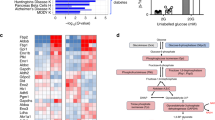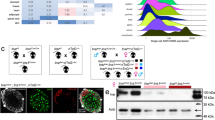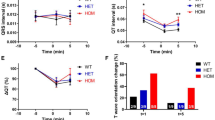Abstract
Mitochondrial dysfunction is an important contributor to human pathology1,2,3,4 and it is estimated that mutations of mitochondrial DNA (mtDNA) cause approximately 0.5–1% of all types of diabetes mellitus5,6. We have generated a mouse model for mitochondrial diabetes by tissue-specific disruption of the nuclear gene encoding mitochondrial transcription factor A (Tfam, previously mtTFA; ref. 7) in pancreatic β-cells. This transcriptional activator is imported to mitochondria, where it is essential for mtDNA expression and maintenance8,9. The Tfam-mutant mice developed diabetes from the age of approximately 5 weeks and displayed severe mtDNA depletion, deficient oxidative phosphorylation and abnormal appearing mitochondria in islets at the ages of 7–9 weeks. We performed physiological studies of β-cell stimulus–secretion coupling in islets isolated from 7–9-week-old mutant mice and found reduced hyperpolarization of the mitochondrial membrane potential, impaired Ca2+-signalling and lowered insulin release in response to glucose stimulation. We observed reduced β-cell mass in older mutants. Our findings identify two phases in the pathogenesis of mitochondrial diabetes; mutant β-cells initially display reduced stimulus–secretion coupling, later followed by β-cell loss. This animal model reproduces the β-cell pathology of human mitochondrial diabetes and provides genetic evidence for a critical role of the respiratory chain in insulin secretion.
This is a preview of subscription content, access via your institution
Access options
Subscribe to this journal
Receive 12 print issues and online access
$209.00 per year
only $17.42 per issue
Buy this article
- Purchase on Springer Link
- Instant access to full article PDF
Prices may be subject to local taxes which are calculated during checkout





Similar content being viewed by others
References
Wallace, D.C. Mitochondrial diseases in man and mouse. Science 283, 1482–1488 (1999).
Larsson, N.G. & Clayton, D.A. Molecular genetic aspects of human mitochondrial disorders. Annu. Rev. Genet. 29, 151–178 (1995).
Larsson, N.G. & Luft, R. Revolution in mitochondrial medicine. FEBS Lett. 455, 199–202 (1999).
Graff, C., Clayton, D.A. & Larsson, N.G. Mitochondrial medicine—recent advances. J. Int. Med. 246, 11–23 (1999).
Kadowaki, T. et al. A subtype of diabetes mellitus associated with a mutation of mitochondrial DNA. N. Engl. J. Med. 330, 962–968 (1994).
Majamaa, K. et al. Epidemiology of A3243G, the mutation for mitochondrial encephalomyopathy, lactic acidosis, and strokelike episodes: prevalence of the mutation in an adult population. Am. J. Hum. Genet. 63, 447–454 (1998).
Parisi, M.A. & Clayton, D.A. Similarity of human mitochondrial transcription factor 1 to high mobility group proteins. Science 252, 965–969 (1991).
Larsson, N.G. et al. Mitochondrial transcription factor A is necessary for mtDNA maintenance and embryogenesis in mice. Nature Genet. 18, 231–236 (1998).
Wang, J. et al. Dilated cardiomyopathy and atrioventricular conduction blocks induced by heart-specific inactivation of mitochondrial DNA gene expression. Nature Genet. 21, 133–137 (1999).
Postic, C. et al. Dual roles for glucokinase in glucose homeostasis as determined by liver and pancreatic β cell-specific gene knock-outs using Cre recombinase. J. Biol. Chem. 274, 305–315 (1999).
Kulkarni, R.N. et al. Tissue-specific knockout of the insulin receptor in pancreatic beta cells creates an insulin secretory defect similar to that in type 2 diabetes. Cell 96, 329–339 (1999).
Gannon, M., Postic, C., Shiota, C., Wright, C.V.E. & Magnuson, M.A. Cre-mediated recombination driven by rat insulin promoter in embryonic and adult mouse pancreas. Genesis 26, 139–141 (2000).
Kobayashi, T. et al. In situ characterization of islets in diabetes with a mitochondrial DNA mutation at nucleotide position 3243. Diabetes 46, 1567–1571 (1997).
Otabe, S. et al. Molecular and histological evaluation of pancreata from patients with a mitochondrial gene mutation associated with impaired insulin secretion. Biochem. Biophys. Res. Commun. 259, 149–156 (1999).
Berggren, P.O. & Larsson, O. Ca2+ and pancreatic B-cell function. Biochem. Soc. Trans. 22, 12–18 (1994).
Velho, G. et al. Clinical phenotypes, insulin secretion, and insulin sensitivity in kindreds with maternally inherited diabetes and deafness due to mitochondrial tRNALeu(UUR) gene mutation. Diabetes 45, 478–487 (1996).
Soejima, A. et al. Mitochondrial DNA is required for regulation of glucose-stimulated insulin secretion in a mouse pancreatic beta cell line, MIN6. J. Biol. Chem. 271, 26194–26199 (1996).
Kennedy, E.D., Maechler, P. & Wollheim, C.B. Effects of depletion of mitochondrial DNA in metabolism secretion coupling in INS-1 cells. Diabetes 47, 374–380 (1998).
Guenifi, A., Abdel-Halim, S.M., Hoog, A., Falkmer, S. & Östenson, C.G. Preserved β-cell density in the endocrine pancreas of young, spontaneously diabetic Goto-Kakizaki (GK) rats. Pancreas 10, 148–153 (1995).
Lacy, P.E. & Kostianowsky, M.K. Method for the isolation of intact islets of Langerhans from the rat pancreas. Diabetes 16, 35–39 (1967).
Kanatsuna, T., Lernmark, A., Rubenstein, A.H. & Steiner, D.F. Block in insulin release from column-perifused pancreatic β-cells induced by islet cell surface antibodies and complement. Diabetes 30, 231–234 (1981).
Acknowledgements
N.-G.L. is supported by grants from the Swedish Medical Research Council, Swedish Heart and Lung Foundation, Petrus och Augusta Hedlunds Stiftelse, Emil och Vera Cornells Stiftelse, Funds of Karolinska Institutet and Novo Nordisk Pharma AB. C.G. is supported by a grant from the Swedish Diabetes Association, The Swedish Society of Medicine and Knut and Alice Wallenberg Stiftelse. J.S. is supported by a stipend from the Roche Research Foundation. A.O. is supported by a grant from the Swedish Medical Research Council. P.-O.B. is supported by grants from the Swedish Medical Research Council, the Swedish Diabetes Association, the Nordic Insulin Foundation Committee, Funds of Karolinska Institutet, Berth von Kantzows Foundation, Juvenile Diabetes Foundation International, the Swedish Society for Medical Research and the Novo Nordisk Foundation.
Author information
Authors and Affiliations
Corresponding author
Rights and permissions
About this article
Cite this article
Silva, J., Köhler, M., Graff, C. et al. Impaired insulin secretion and β-cell loss in tissue-specific knockout mice with mitochondrial diabetes. Nat Genet 26, 336–340 (2000). https://doi.org/10.1038/81649
Received:
Accepted:
Issue Date:
DOI: https://doi.org/10.1038/81649
This article is cited by
-
β-cell mitochondria in diabetes mellitus: a missing puzzle piece in the generation of hPSC-derived pancreatic β-cells?
Journal of Translational Medicine (2022)
-
SENP2 regulates mitochondrial function and insulin secretion in pancreatic β cells
Experimental & Molecular Medicine (2022)
-
ATP synthase inhibitory factor subunit 1 regulates islet β-cell function via repression of mitochondrial homeostasis
Laboratory Investigation (2022)
-
Metabolism-secretion coupling in glucose-stimulated insulin secretion
Diabetology International (2022)
-
Contribution of specific ceramides to obesity-associated metabolic diseases
Cellular and Molecular Life Sciences (2022)



